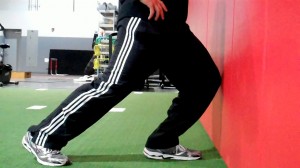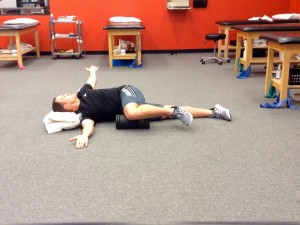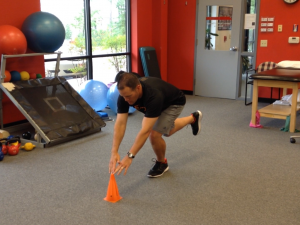Brian Schiff’s Blog
Injury Prevention, Sports Rehab & Performance Training Expert
Whether doing prehab, rehab or training, I believe in using single leg exercises to attack asymmetries, imbalances and motor deficits I uncover in my assessments. Learning to control one’s body in space with the effect of gravity in a weight bearing position is instrumental for sport and injury prevention.
Furthermore, facilitating ankle mobility and proper knee alignment during a loaded squat pattern is something most athletes and clientele I work with need some help with. to that end, I utilize several different single leg reaching progressions and exercises. One of my favorite ‘go to’ exercises is the anterior cone reach.
I recently featured this specific exercise in my ‘Functionally Fit’ column for PFP Magazine. Click here to see the video demonstration.
This is a great exercise with progressions and regressions for clients of all ages and abilities.
 As a father, coach and physical therapist working in a sports medicine environment, I am all too familiar with youth injuries. While we can not prevent every injury, I do believe we need to do everything possible to keep our young athletes out of harm’s way. In today’s ultra competitive society, parents are faced with pressure to “keep up” or fall behind.
As a father, coach and physical therapist working in a sports medicine environment, I am all too familiar with youth injuries. While we can not prevent every injury, I do believe we need to do everything possible to keep our young athletes out of harm’s way. In today’s ultra competitive society, parents are faced with pressure to “keep up” or fall behind.
Contrary to what research and real life has to say about it, organizations and coaches who want to win now tell parents and players you need to choose one sport at an early age if you want to be the best. I see the club fees that organizations charge, the emotional heartbreak of not making the top tier teams and the grind of all the “extra” training sessions for skill work, speed training, etc. that athletes endure.
Gone are the days where just playing for your school team is enough to garner attention at the next level. It seems as if athletes must play in AAU, clubs, travel teams or showcase opportunities to stand out. It is apparent to me as if we have become hyper focused on training our children to obtain a scholarship at such an early age. Some of the things I hear parents say illustrate to me their are pushing their children very hard to meet these expectations. The idea that sports should be fun for young kids seems to be lost on the coaches and parents in many cases.
My 9 y/o son (picture above running the ball) told me one reason he does not want to play Pop Warner football next Fall is because of all the practice time required. We practiced 5 days per week in August, followed by two hour practices 3 nights per week and a Saturday game during the regular season. He loves the game and was one of the best players on his team, but the time and exhaustive training simply wore him out. So, he says he wants to play soccer next Fall instead. I told him this was fine as he needs to be the one that wants to play – not me telling him to play. He also plays basketball in the Winter and soccer in the Spring.
As a parent, I want to encourage others to listen to their kids and put their own goals and interests aside. We should not try to live vicariously through our kids on the court or field. Sports should not be work for young people, and adults should not care more about the game than the participants at a young age. As coaches and medical professionals, we need to do everything in our power to promote health and life balance for young people.
Running is in full force as Spring has sprung. If you have ever experienced shin pain during or after your training runs, you know firsthand how aggravating this condition can be. I treat many runners with overuse injuries. Common issues include anterior knee pain, IT band pain, plantar fasciitis and of course shin splints.
Click here to read an earlier post on the link between poor ankle mobility and overuse injuries. Unfortunately, shin splints can progress to a more serious stress fracture if not diagnosed and treated properly. Recently, I was interviewed for a series of articles on thew topic of shin splints by Fitness Magazine. You can read those articles below:
How to prevent, treat and heal shin splints
If you follow my blog, you may remember that about this time last year I posted some info about a compilation of body weight training resources. Well, a new version is back for 2015, and as a person who contributed to the project, I wanted to make you aware of the offering. It is available from today until March 27 at 11:59 PM and includes content from different disciplines within the health and fitness community.
Get the NEW Bodyweight Bundle 2.0 bundle here
It includes:
8 Bodyweight muscle building resources
6 Bodyweight fatloss programs
6 Bodyweight “trick” manuals
7 Bodyweight video/workout programs
4 Bodyweight flexibility/rehab programs (including my shoulder e-book)
Plus…
… fat-burning recipes, meal plans and more.
You can harness the power of bodyweight exercises from multiple experts to transform your body and your life. You can own all 37 resources for only $37 for a limited time! Click on the image below for more information.
This post is dedicated to improving mobility in two areas I commonly find restrictions in among my clients – the ankle and thoracic spine. Specifically, I often find limitations in dorsiflexion and thoracic spine rotation that create undue stress on other parts of the kinetic chain.

Standing wall touch
Recently, I wrote an article for the WeckMethod site on how to assess and improve ankle mobility. As a clinician and coach, I see this issue in many runners and athletes I work with. At times, it is joint restriction, while in other cases it is soft tissue limitations that impact mobility.
There are several potential reasons why one might possess less than optimal movement in the ankle. The most common causes include: joint stiffness following injury and/or immobilization, soft tissue tightness in the gastroc/soleus complex, scar tissue from a prior injury, anterior ankle impingement, chronic ankle instability and adaptive shortening of the Achilles tendon. Want to read more?
Click here to read my article on the WeckMethod site
Decreased mobility in the thoracic spine often creates dysfunction and stress on other parts of the kinetic chain, namely the shoulder and lumbar spine. In many cases, clients will demonstrate asymmetry based on their sport, activity level and injury history. In light of this, I often prescribe a simple, yet effective corrective exercise they can do at home to restore motion. The exercise below is taken from my ‘Functionally Fit’ column I recently did for PFP Magazine.

Side lying t-spine roll
In the full online column, I reveal two ways to do this and the applications for it. This exercise also offers a way to assess your own range of motion, while teaching you a straightforward corrective exercise to improve mobility.





